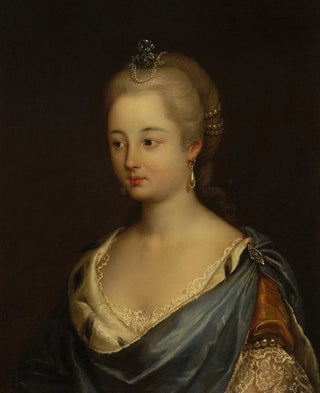Art print | Portrait of Mrs. Kruszewska née Komorowska - Józef Simmler


View from behind

Frame (optional)
Józef Simmler’s "Art print of Mme Kruszewska née Komorowska" is a work that transcends the simple frame of a painting to offer a journey through time and space, evoking an era when art reflected the morals and values of society. This iconic piece, which captures the very essence of its subject, immerses us in the universe of 19th-century Polish nobility. Through this portrait, Simmler does not merely depict a woman but immortalizes a personality, a story, and a way of life. The elegance of the composition and the finesse of the details make this work a true masterpiece that engages and fascinates.
Style and uniqueness of the work
Simmler’s style is characterized by meticulous attention to detail and a keen sense of color. In the "Art print of Mme Kruszewska née Komorowska," the artist manages to capture not only the physical features of his model but also her character and spirit. The sumptuous drapery of the dress, the reflections of light on the fabrics, and the softness of Mme Kruszewska’s features testify to a mastered technique and an exceptional sense of observation. The color palette chosen by Simmler, both rich and delicate, creates an intimate atmosphere that invites the viewer to approach and contemplate. This portrait is a celebration of feminine beauty but also a reflection on the role of women in the society of its time, a theme dear to the artist.
The artist and his influence
Józef Simmler, an emblematic figure of 19th-century Polish painting, established himself through his distinctive style and his ability to capture the soul of his subjects. Trained in the best art schools, he was influenced by the great European masters while developing a personal approach that is uniquely his own. Simmler successfully combined tradition and innovation, integrating elements of Romanticism into his work while respecting the conventions of the classical portrait. His impact on the Polish art scene is undeniable, inspiring many contemporary artists to explore the nuances of human representation. The "Art print of Mme

Matte finish

View from behind

Frame (optional)
Józef Simmler’s "Art print of Mme Kruszewska née Komorowska" is a work that transcends the simple frame of a painting to offer a journey through time and space, evoking an era when art reflected the morals and values of society. This iconic piece, which captures the very essence of its subject, immerses us in the universe of 19th-century Polish nobility. Through this portrait, Simmler does not merely depict a woman but immortalizes a personality, a story, and a way of life. The elegance of the composition and the finesse of the details make this work a true masterpiece that engages and fascinates.
Style and uniqueness of the work
Simmler’s style is characterized by meticulous attention to detail and a keen sense of color. In the "Art print of Mme Kruszewska née Komorowska," the artist manages to capture not only the physical features of his model but also her character and spirit. The sumptuous drapery of the dress, the reflections of light on the fabrics, and the softness of Mme Kruszewska’s features testify to a mastered technique and an exceptional sense of observation. The color palette chosen by Simmler, both rich and delicate, creates an intimate atmosphere that invites the viewer to approach and contemplate. This portrait is a celebration of feminine beauty but also a reflection on the role of women in the society of its time, a theme dear to the artist.
The artist and his influence
Józef Simmler, an emblematic figure of 19th-century Polish painting, established himself through his distinctive style and his ability to capture the soul of his subjects. Trained in the best art schools, he was influenced by the great European masters while developing a personal approach that is uniquely his own. Simmler successfully combined tradition and innovation, integrating elements of Romanticism into his work while respecting the conventions of the classical portrait. His impact on the Polish art scene is undeniable, inspiring many contemporary artists to explore the nuances of human representation. The "Art print of Mme






